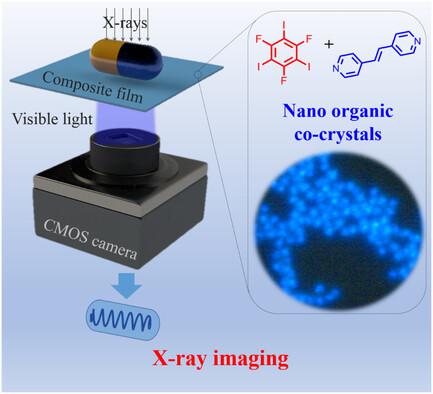当前位置:
X-MOL 学术
›
Small Struct.
›
论文详情
Our official English website, www.x-mol.net, welcomes your
feedback! (Note: you will need to create a separate account there.)
Nano Organic Co-Crystal Scintillator for X-ray Imaging
Small Structures ( IF 13.9 ) Pub Date : 2023-04-29 , DOI: 10.1002/sstr.202200275 Qisheng Sun 1, 2 , Hongyun Wang 1 , Jing Li 1 , Fei Li 3 , Weigang Zhu 1 , Xiaotao Zhang 1, 3 , Qiushui Chen 4 , Huanghao Yang 4 , Wenping Hu 1, 2, 5
Small Structures ( IF 13.9 ) Pub Date : 2023-04-29 , DOI: 10.1002/sstr.202200275 Qisheng Sun 1, 2 , Hongyun Wang 1 , Jing Li 1 , Fei Li 3 , Weigang Zhu 1 , Xiaotao Zhang 1, 3 , Qiushui Chen 4 , Huanghao Yang 4 , Wenping Hu 1, 2, 5
Affiliation

|
Traditional-metal-containing scintillators are widely used in X-ray imaging due to their efficient X-ray absorption and output of visible light. However, they suffer from heavy-metal toxicity, environmental stability, harsh preparation, and afterglow. Metal-free organic scintillators show a rising momentum, especially organic-halogen-containing molecules. Halogens are introduced to improve their X-ray absorption, but the resulting increase in spin–orbit coupling leads to significant delayed fluorescence or phosphorescence, affecting the response speed to X-rays. Moreover, there is still insufficient practice in fabricating microstructured organic scintillators for high spatial resolution of imaging. Herein, the preparation of nano organic co-crystals (t-Bpe-IFB co-crystal, abbreviated as BIC, t-Bpe for trans-1,2-bis(4-pyridyl)ethylene, and IFB for 1,3,5-trifluoro-2,4,6-triiodobenzene) and its application in X-ray imaging are explored. In contrast to previous single organic-halogen-containing molecules, BIC generates nanosecond-scale fluorescence through the charge-transfer state of the donor–acceptor. Its high iodine content ensures large X-ray absorption, strong radioluminescence, and a low detection limit of 85 nGyair s−1. The composite film made of nano-sized BICs and polydimethylsiloxane exhibits a high spatial resolution of 16.7 lp mm−1. Herein, the application of organic co-crystals is expanded and ideas are provided for the development of new scintillators.
中文翻译:

用于 X 射线成像的纳米有机共晶闪烁体
传统的含金属闪烁体由于其有效的 X 射线吸收和可见光输出而广泛应用于 X 射线成像。然而,它们存在重金属毒性、环境稳定性、制备条件苛刻和余辉等问题。无金属有机闪烁体显示出上升势头,尤其是含有机卤素分子。引入卤素是为了提高其对X射线的吸收,但由此产生的自旋轨道耦合的增加会导致荧光或磷光的显着延迟,影响对X射线的响应速度。此外,在制造用于高空间分辨率成像的微结构有机闪烁体方面仍然缺乏足够的实践。本文介绍了纳米有机共晶(t- Bpe-IFB共晶,缩写为BIC,t- Bpe为反式-1,2-双(4-吡啶基)乙烯,IFB为1,3,5)的制备-三氟-2,4,6-三碘苯)及其在X射线成像中的应用进行了探讨。与之前的单一有机卤素分子相比,BIC 通过供体-受体的电荷转移状态产生纳秒级荧光。其高碘含量确保了大的X射线吸收、强的放射发光以及85 nGy air s -1的低检测限。由纳米BIC和聚二甲基硅氧烷制成的复合膜表现出16.7 lp mm -1的高空间分辨率。拓展了有机共晶的应用,为新型闪烁体的开发提供了思路。
更新日期:2023-04-29
中文翻译:

用于 X 射线成像的纳米有机共晶闪烁体
传统的含金属闪烁体由于其有效的 X 射线吸收和可见光输出而广泛应用于 X 射线成像。然而,它们存在重金属毒性、环境稳定性、制备条件苛刻和余辉等问题。无金属有机闪烁体显示出上升势头,尤其是含有机卤素分子。引入卤素是为了提高其对X射线的吸收,但由此产生的自旋轨道耦合的增加会导致荧光或磷光的显着延迟,影响对X射线的响应速度。此外,在制造用于高空间分辨率成像的微结构有机闪烁体方面仍然缺乏足够的实践。本文介绍了纳米有机共晶(t- Bpe-IFB共晶,缩写为BIC,t- Bpe为反式-1,2-双(4-吡啶基)乙烯,IFB为1,3,5)的制备-三氟-2,4,6-三碘苯)及其在X射线成像中的应用进行了探讨。与之前的单一有机卤素分子相比,BIC 通过供体-受体的电荷转移状态产生纳秒级荧光。其高碘含量确保了大的X射线吸收、强的放射发光以及85 nGy air s -1的低检测限。由纳米BIC和聚二甲基硅氧烷制成的复合膜表现出16.7 lp mm -1的高空间分辨率。拓展了有机共晶的应用,为新型闪烁体的开发提供了思路。

































 京公网安备 11010802027423号
京公网安备 11010802027423号